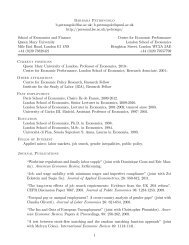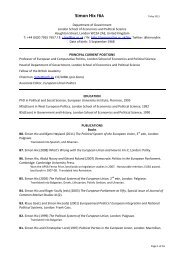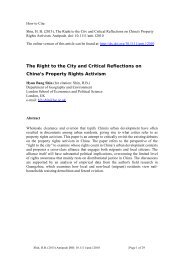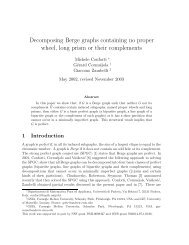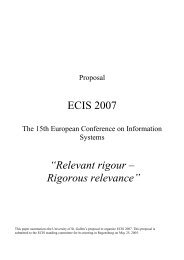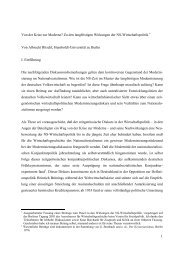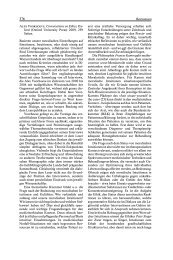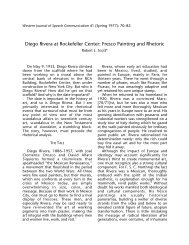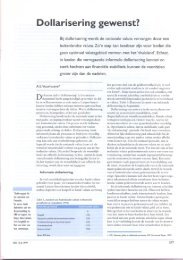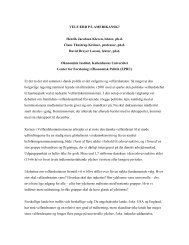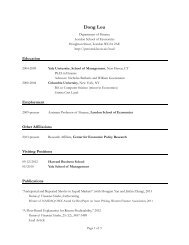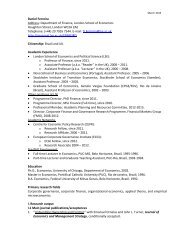The Rejected, the Ejected, and the Dejected: Explaining ...
The Rejected, the Ejected, and the Dejected: Explaining ...
The Rejected, the Ejected, and the Dejected: Explaining ...
Create successful ePaper yourself
Turn your PDF publications into a flip-book with our unique Google optimized e-Paper software.
Benedetto, Hix / Government Rebels in House of Commons 767<br />
26.7% junior ministers, <strong>and</strong> 18.6% ex-ministers in <strong>the</strong> full set of 408<br />
Labour MPs. 6<br />
Third, <strong>the</strong> term CONSTITUENCY_EFFECTS is a vector of several<br />
variables that control for a variety of potential constituency pressures on<br />
Labour MPs. Two of <strong>the</strong>se variables appear in all <strong>the</strong> models: (a) <strong>the</strong> percentage<br />
of votes received by <strong>the</strong> elected Labour MP in his or her constituency<br />
minus <strong>the</strong> percentage of votes received by <strong>the</strong> second-largest<br />
party in <strong>the</strong> constituency (majority size) <strong>and</strong> (b) <strong>the</strong> estimated location of<br />
<strong>the</strong> median voter in <strong>the</strong> MP’s constituency (constituency median voter). <strong>The</strong><br />
data on <strong>the</strong> constituency vote shares were obtained from Pippa Norris’s<br />
(2002b) “British Parliamentary Constituency Database, 1992-2001.” <strong>The</strong><br />
location of <strong>the</strong> median voter in a district was calculated by multiplying<br />
<strong>the</strong> vote share for a particular party in a constituency by <strong>the</strong> location of <strong>the</strong><br />
party on a 20-point left-right scale. For <strong>the</strong> left-right location of <strong>the</strong> British<br />
parties, we used Benoit <strong>and</strong> Laver’s (2006) expert judgments data. For<br />
example, if <strong>the</strong> Conservative Party (to <strong>the</strong> right of Labour) is <strong>the</strong> secondlargest<br />
party in <strong>the</strong> constituency (which Benoit <strong>and</strong> Laver measured as at<br />
16.39), no o<strong>the</strong>r parties received a significant vote share <strong>and</strong> Labour only<br />
has a small majority in <strong>the</strong> constituency, <strong>the</strong>n <strong>the</strong> median voter in <strong>the</strong> constituency<br />
will be to <strong>the</strong> right of <strong>the</strong> position of <strong>the</strong> Labour Party (at 10.95).<br />
Alternatively, if <strong>the</strong> liberal Democrats (at 7.91) or <strong>the</strong> Scottish or Welsh<br />
nationalists (at 7.13 <strong>and</strong> 6.02, respectively) are <strong>the</strong> second-largest party<br />
in <strong>the</strong> constituency <strong>and</strong> <strong>the</strong> Conservative vote share is small, <strong>the</strong>n <strong>the</strong><br />
median voter will be to <strong>the</strong> left of <strong>the</strong> Labour Party. Using this method, <strong>the</strong><br />
location of <strong>the</strong> median voter in each Labour-held constituency ranged from<br />
9.11 (in Birmingham Sparkbrook) to 12.82 (in Kettering).<br />
In <strong>the</strong> models of Labour MPs’ voting behavior on <strong>the</strong> three separate highprofile<br />
votes, we include o<strong>the</strong>r constituency interests that might influence<br />
MPs’ views in <strong>the</strong>se votes. For <strong>the</strong> vote on <strong>the</strong> Iraq War, we include <strong>the</strong> percentage<br />
of Muslims in an MP’s constituency (% Muslim). For <strong>the</strong> vote on <strong>the</strong><br />
reform of <strong>the</strong> National Health Service, we include <strong>the</strong> percentage of people in<br />
an MP’s constituency who describe <strong>the</strong>mselves as having “poor health” (%<br />
poor health). And, for <strong>the</strong> vote on higher education funding, we include <strong>the</strong><br />
percentage of people in an MP’s constituency who are full-time students older<br />
than <strong>the</strong> age of 16 (% students). <strong>The</strong> data for <strong>the</strong>se variables were collected<br />
from <strong>the</strong> 2001 census “Key Statistics Databases” of <strong>the</strong> Office for National<br />
Statistics (Engl<strong>and</strong> <strong>and</strong> Wales) <strong>and</strong> <strong>the</strong> General Register Office for Scotl<strong>and</strong>. 7<br />
Fourth, <strong>the</strong> CONTROLS term is a vector of two variables. First, our<br />
<strong>the</strong>ory assumes that MPs are seeking reelection <strong>and</strong> so are beholden to <strong>the</strong>ir<br />
party leaders. Hence, we need to control for whe<strong>the</strong>r an MP is retiring at<br />
Downloaded from<br />
http://cps.sagepub.com at SWETS WISE ONLINE CONTENT on July 6, 2007<br />
© 2007 SAGE Publications. All rights reserved. Not for commercial use or unauthorized<br />
distribution.



